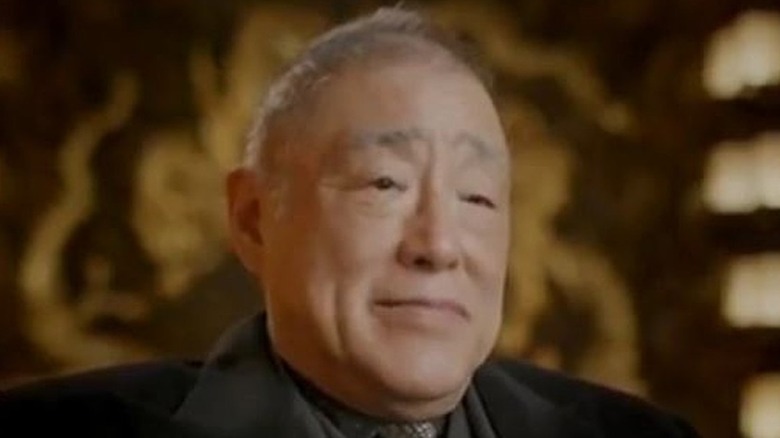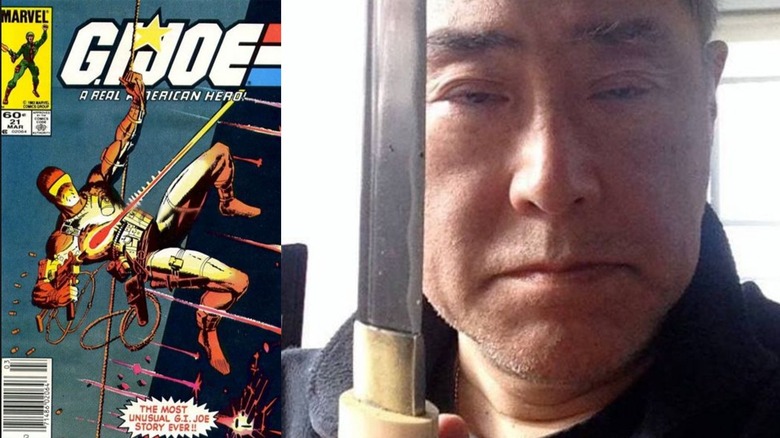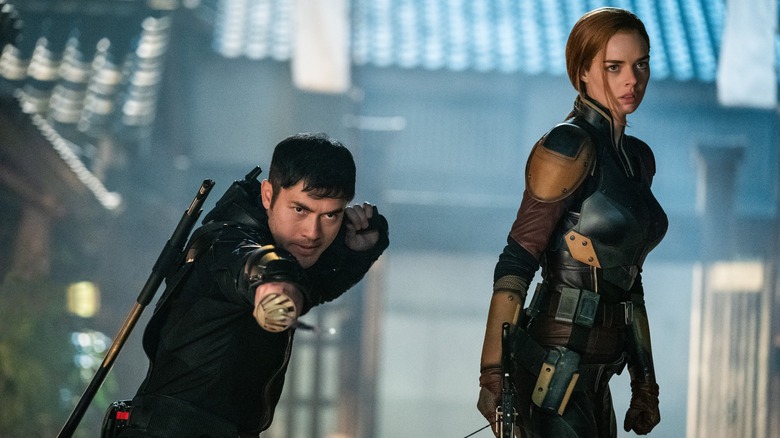Larry Hama Reveals The Real Reason He Wrote The G.I. Joe Comics - Exclusive
Since the first issue of Marvel Comics' "G.I. Joe: A Real American Hero" was published in 1982, there's no doubt that the comic book's creator, Larry Hama, and his characters have become real American icons. Along with the publication of the comic book came the debut of Hasbro Toys' "G.I. Joe" 3 3/4-inch action figures, scaled down from the 12-inch line that transformed the toy industry in 1964.
A year after its comic book debut, the "G.I. Joe: A Real American Hero" animated series hit the small screen, and the characters were eventually realized in live-action form on the big screen with "G.I. Joe" movies in 2009 and 2013. In July of 2021, Hama saw his favorite characters come to life in the live-action realm once again when "Snake Eyes: G.I. Joe Origins" was released.
While the monolithic growth of the franchise seems to be part of a master plan devised by Hama nearly four decades ago, in reality, the story of how the "G.I. Joe" comic book came to be is quite the opposite. In fact, the reason he took on the assignment from Marvel was fairly simple.
Hama says the G.I. Joe comic books were 'a foot in the door' for writing work
In an exclusive interview with Looper to discuss the release of "Snake Eyes: G.I. Joe Origins" on digital HD and premium video on demand, Hama revealed the real reason he signed on to write "G.I. Joe" comics. Essentially, after every writer at Marvel passed on the chance to create the comic book, Hama was finally provided the opportunity he was seeking for a decade.
"It was my foot in the door to get writing work. I'd been trying for 10 years to get writing work. No editor at Marvel would give me writing work," Hama told Looper. "It was company policy that if you were an editor, you couldn't write for another company, but I had special dispensation from the editor-in-chief to write for Warren Comics because I was able to go to him and prove to him that I had gone to every editor at Marvel, and nobody would give me any writing work."
In fact, even though Hama was a U.S. Army veteran who served during the Vietnam War from 1969 to 1971, he wasn't looking to tell stories about the military.
"It was an opportunity to tell certain types of stories, but it has never been my intention to do military comics," Hama revealed. "I wanted to do funny animals from the get-go, but nobody was buying funny animals, so I had to do superheroes. I fell into 'G.I. Joe' completely by accident. If they had offered me Barbie, I would have taken Barbie and given it my best shot because I wanted to work. I wanted the writing work.
The G.I. Joe characters aren't superheroes and supervillains
One of the most interesting aspects of the "G.I. Joe" comic books is that they were published by Marvel Comics, a brand associated with such legendary superheroes as Spider-Man, Iron Man, the Incredible Hulk, and The Avengers. Even so, while Marvel gave birth to the "G.I. Joe" comic book franchise, Hama said he doesn't consider his characters as superheroes battling supervillains.
"I'm not really a superhero guy. It's a harder fantasy for me to swallow. I mean, the sort of superhero or mutant characters that I've worked with [Wolverine, X-Men] were less super. They had powers, but they were more on the human side," Hama explained. "In a way, superheroes are sort of a fascist fantasy. It's like the Ubermensch [idea by Friedrich Nietzsche]. It's like this outside entity that comes in and is much stronger and could beat up all the bad guys."
Essentially, Hama added, his concept of "G.I. Joe" surrounds the idea of people forming bonds to get the job done.
"The G.I. Joe fantasy was not as much a military fantasy or a superhero fantasy as it was a fantasy about camaraderie and brotherhood and working together — and that's the way I saw it," he said. "In fact, I've said this before, but I've always been a Carl Barks 'Uncle Scrooge' fan, and still am. So, in my head, basically, 'G.I. Joe' was 'The Junior Woodchucks' with guns."
Larry Hama supports G.I. Joe in both the comic book and movie realms
"Snake Eyes: G.I. Joe Origins" is a departure from the comic book series in that the back story of Snake Eyes (Henry Golding) and his blood brother-turned-nemesis Storm Shadow (Andrew Koji) was switched from the Vietnam War to modern times. Also, Snake Eyes doesn't appear as the silent, masked character in the comics whose face was disfigured and who lost his ability to speak when his vocal cords were damaged in a helicopter explosion.
Addressing any fans' resistance to such big changes, Hama — who gave his blessing to the production to take creative license with the character — said he supported the changes made to Snake Eyes. Effectively, he said the storylines in comic books and movies "can co-exist, but they're two different mediums."
"There are things that work in comics that just don't work on screen, because comics are ... It's a medium where you learn everything by increments," Hama observed. "You read Batman for 20 years, you know an awful lot about Batman, but you've learned it in little bits and pieces every month. In a movie, you've got 90 minutes to two hours, to get it all up there." As such, "the methodology of getting the information across is very different," he added.
"In comics, you have to show it visually and make it work as a flow of pictures. In movies, you've got sound effects, you've got the ability to do all this stuff. And a lot of comic book tricks and storytelling methods were copied from movies," Hama said. "And so, it's this weird back-and-forth. Both mediums feed on each other."
"Snake Eyes" is available on digital HD and premium video on demand, and debuts on 4K Ultra HD Blu-ray, Blu-ray, DVD, and On Demand on October 19.



